Cardano 101: A Beginner’s Journey into the World of $ADA and Blockchain
This beginner’s guide introduces Cardano, an innovative blockchain platform that boasts a unique architecture, native token $ADA, and a promising future in the realm of blockchain technology.
Cardano is a groundbreaking, open-source blockchain platform co-founded by Charles Hoskinson, a former Ethereum co-founder. The platform stands out with its research-oriented approach, prioritizing peer-reviewed academic research to guarantee secure, scalable, and sustainable technology.
The two-layered architecture of Cardano consists of the Cardano Settlement Layer (CSL) for transactions and the Cardano Computation Layer (CCL) for smart contracts and decentralized applications (dApps). This dual-layer structure enhances scalability, flexibility, and security, as each layer can be independently upgraded and optimized.
Ouroboros, Cardano’s Proof of Stake (PoS) consensus mechanism, offers a more energy-efficient and eco-friendly alternative to the Proof of Work (PoW) system used by platforms like Bitcoin and Litecoin. $ADA holders can participate in the network’s validation process by staking their tokens and receiving rewards for contributing to network security and stability.
$ADA, Cardano’s native cryptocurrency, is utilized for transactions, smart contract execution, and platform governance. $ADA holders can stake their tokens in Cardano’s PoS system by either delegating their stake to a stake pool or running their own stake pool to validate transactions and earn rewards.
Cardano provides developers with the tools to create dApps on its platform, taking advantage of the blockchain’s distinctive architecture and security features. Cardano’s smart contracts are crafted using Plutus, a Haskell-based programming language known for its high security and reliability. As Cardano’s ecosystem expands, a diverse array of dApps spanning industries such as finance, supply chain, and gaming is anticipated, further broadening its utility and potential impact.
Cardano continually refines its platform with ongoing developments to enhance its governance model, achieve greater interoperability with other blockchains, and fine-tune its smart contract capabilities. The platform seeks mass adoption by focusing on industries like agriculture, education, and healthcare, where blockchain technology can yield significant benefits. As the Cardano ecosystem matures and attracts more developers and users, the number of dApps and use cases built on the platform will likely grow, solidifying Cardano’s position as a major player in the blockchain technology space.
https://youtube.com/watch?v=Elwv7Itr1qA%3Ffeature%3Doembed
Image Credit
Featured Image via Unsplash
Source: Read Full Article

